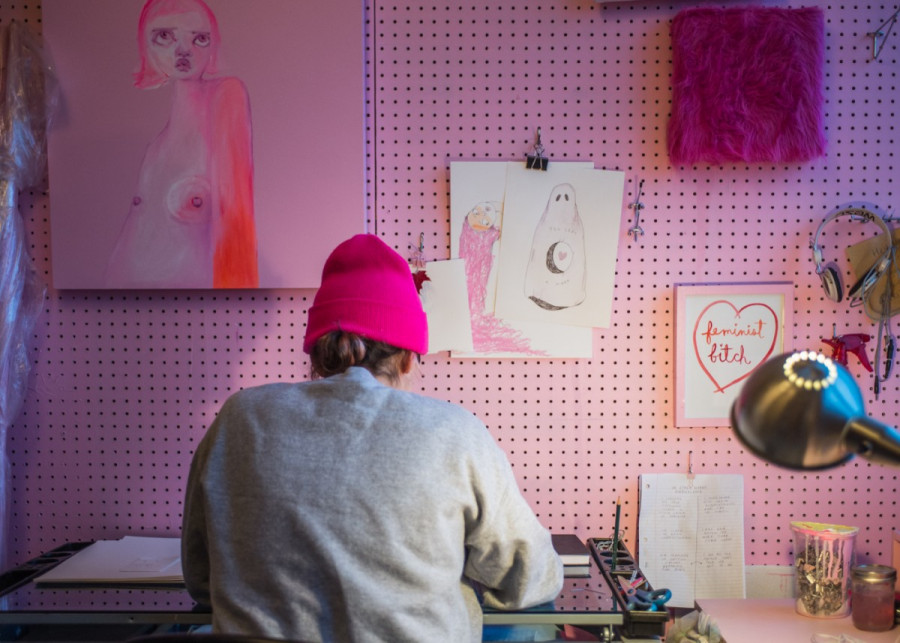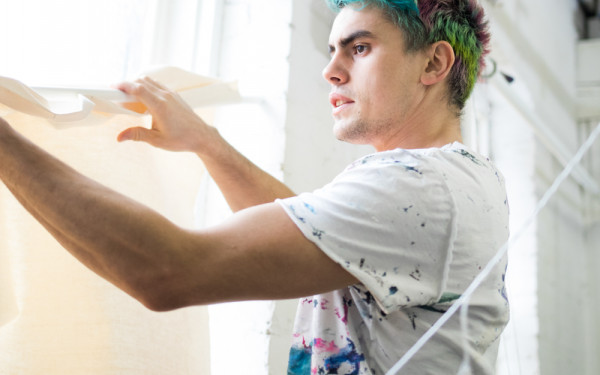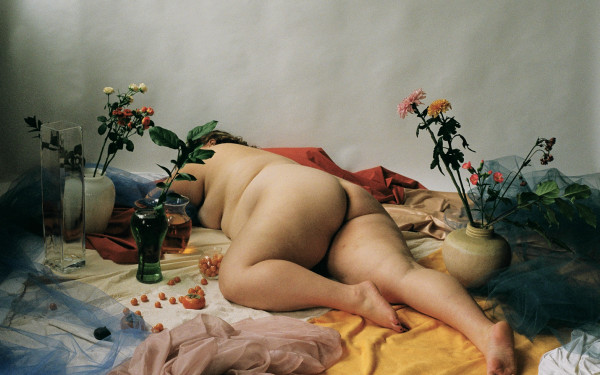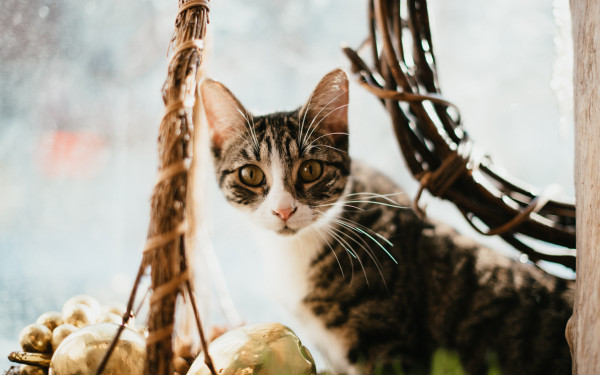Ambivalently Yours: Using the Colour Pink as a Tool Against the Patriarchy
The Montreal Artist Split Between Loving Femininity and Realizing That It’s Part of the System She’s Constantly Fighting
My softness is my armour,” reads one. “Learning to hate myself less in small increments one tiny piece at a time,” reads another.
Flirty pinks and soft pastels colour Ambivalently Yours’ Instagram page. The Montreal artist often uses the internet as a medium to remain anonymous in her work, although the vulnerability she communicates through her pieces is synonymous to her identity.
Through her art, the viewer is given space to rest, settle into themselves, and mull over the intrinsic emotions of what it means to be alive and exist with a myriad of emotions. She has created a platform where experiencing emotions is okay, which helps to validate people’s lived experiences.
Ambivalence, which means having opposing feelings (like attraction and repulsion) toward something or someone, is the root of her artistic practice.
Her content is emotionally raw, coupled with sweet and slightly creepy illustrations.With it she opens up the dialogue for women to question their confusing relationships with the patriarchy and to express their vulnerability, passion and uncertainty.
AY tends to use rounded lines in her art, and her curious illustrations follow a theme of strange, malleable-looking figures with large eyes drawn with delicate penmanship.
AY couples her artwork, which stems from a tender place, with an unapologetically raw short statement or poem rooted in emotion.
“[My work] is a lot about validating my own feelings, and trying to validate the feelings of everybody [else],” she explained, “which is feminist in its nature.”
Typically creating her work with a simple ballpoint pen on paper with some watercolour paint, AY scans and posts her work on her online platforms like Instagram, Tumblr and Twitter. She also creates animations and GIFs, and has a small line of tangible work that she sells online and at markets, like pins, patches and shirts.
“It’s important for me to share [my art] because it’s a form of communication; it’s a way that I found to express things that I can’t express with words alone.”
The vulnerability that she demonstrates in her art is intentional; publishing her work and getting a response from her followers helps AY feel like she’s less isolated in her feelings.
“It’s really important to listen to your emotions, and I think being an emotional person is a gift in a way. But [there’s] a fine line between being an emotional person and being completely overrun by your emotions. So, in a way, art is a way for me to try to balance that a bit.”
AY explains that sharing her work helps her let go of the consuming emotion she tries to convey through her art.
“A lot of the time when I make this art and it’s really emotional, the act of making that art lets me let go of that emotion. If I put it out there, it’s over, […] it’s further away from me. Sharing something publicly lets me kind of let go of it a bit; it [doesn’t] consume me as much.”
The use of pink helps her to express her work in the most candid way possible. She often uses the Pantone shade 1895.
AY tried to use other colours in her art in the past, but she always felt like something was missing once the piece was finished. She explained that her art was dishonest if it wasn’t dipped in that hue of pink. “I decided to just give in to that aesthetic joy of that colour.”
AY now uses the same light, warm pink as the background of all of her work. This has led her to feel like every work of art she creates is part of a continuous project.
“All of my drawings are that same shade of pink, so in a sense I see it as one big, never ending big piece, with little mini projects inside.”
Her trademark aspect of using pink infused her artwork with deeper meaning. AY’s previous career in the fashion industry, and the contradictions she came across increased her desire to incorporate pink into her art.
AY completed a BFA and MFA in studio art.
She recounted how negative assumptions were often made about her by classmates and colleagues in the fashion industry because of her feminist slant was combined with feminine pinks. The two were viewed as irreconcilable opposing forces.
“They […] thought that I was being duped by the patriarchy, in a way. Like I didn’t realize that all of these things that I really loved were […] part this system.”
At the fashion company she worked for, she had a marketing position which slowly led her to a negative change of mind about the industry.
“Marketing is a lot about creating needs, like making people feel like they need something, and that need is also born from you missing something. ‘If you buy this thing then it will get you closer to that thing that you’re missing, and that need will lead you to happiness, relationships or fame.’”

“That whole manipulative aspect of it; the more I learned about feminism, the more I understood what it all meant, and the less I wanted to participate in it,” said AY.
While she understands this, she still loves fashion.
“It’s hard, because I like clothes, I like makeup, I like pretty things, and so there’s a part of me that is drawn to that, and that still falls for it. Then there’s [another] part of me that doesn’t want [to]. I was having a lot of mixed feelings about moving forward, and about the art I wanted to make, and so I eventually decided to embrace those mixed feelings.”
She realized then that she was feeling ambivalent, and used it to brand her work, which ultimately changed her way of life.
Instead of being a radical feminist and rejecting everything, or the fashion girl who loves everything, she decided to “be both and neither at the same time.”
Ambivalence, which means having opposing feelings (like attraction and repulsion) toward something or someone, is the root of her artistic practice.
A major part of her artistic practice is its interactive aspect. AY started publishing her artwork online in 2011 when she was in graduate school. Her followers gave such a positive response to the sensitivity in the work she originally created that she decided to open up her art to the audience.
It quickly became an interactive performance. People would ask her for advice as an ‘anon’—anonymous user on Tumblr—and she would create an illustration to go with her response to them.
She uses this inspiration and practice in her art today, but to a lesser extent because of the decline in Tumblr’s popularity.
She now uses Instagram as her main medium because it gives her a larger reach than she would ever get displaying her work in a regular exhibit, allowing her to spread her message of tenderness and the strength of femininity to more people.
It also gives her the opportunity to foster close, communicative relationships with people that begin with them responding to one of her artworks. “In that sense I find it a bit more rewarding,” she said.
Through those exchanges with her followers, she sais she hopes to imbue them with the sensation that the feelings they have, and the messages they send to her, are important. AY explained that it also gives her a chance to think about emotions and feelings from many different perspectives, and encourages communication between others. Many of her followers also have discussions about emotions and vulnerability in the comment section of her posts.
She said being anonymous in her artistry helps with her being able to be completely honest and open about what she’s feeling.
“I use it to be more vulnerable and kinder; I would argue that my online persona is a lot kinder than I’m able to be in real life.”
Geneviève Darling, a friend, illustrator and small business owner of Lovestruck Prints, has collaborated with her on multiple events. They share a small art studio, organize markets in Montreal together and have collaborated on zines. Their most recent work was a zine called “I don’t know what I’m dreaming of anymore,” where Darling wrote a journal-like text and AY answered her questions through her illustrations.
“It was just so heartwarming to see her answers,” said Darling. “All those questions are so uneasy and those answers just softens everything. It’s really [brought] another kind of connection.”
“She’s also obviously very strong for being able to hold all this vulnerability, and make something out of it that is communicable,” Darling continued. “Her art is very strong and sensitive. I really admire her capacity to put into drawings complex feelings, and to make people feel seen and understood.”
“[I wanted to] make work from [an ambivalent] space,” said AY. “And to allow myself to have conflicting ideas, instead of trying to oversimplify how I was feeling. In that sense, when you’re oversimplifying, you’re kind of taking away parts of yourself.”
With a new mindset, she communicated that femininity is positive and should be appreciated by being radically tender and vulnerable through her work.
“Everything that’s associated with femininity is seen as lesser or weak,” she said. “I think there can be a lot of power in femininity, in softness and emotions. A lot of what I try to do with my work is to confront these things, and show that being a tender and emotional person doesn’t equate being weak, or lesser than the strong, bold, [male] archetype.”
“I was trying to be […] critical of mainstream femininity, and how it’s imposed on women, while also embracing the joy that can come from indulging in femininity, or expressing ourselves in a feminine manner,” she continued.
Those concepts have led her many places. AY is currently working on a series that will go live in 2020. It will centre around the concept of ambivalence. For that exhibit, she will create larger pieces than her standard, smaller ones.
She also said she’d d like to publish an anthology of her work in book form sometime in the future.
“I want to do an anthology of those messages and the drawings [from my online platforms]. I feel like it was a really important time on the internet, that Tumblr time,” explained AY. “Making a book would allow it to just exist in its original form.”
She navigates the tenuous boundary that many creators do, the one between art as an outlet and as a source of income.
“It’s tough, especially in the last few years when I’m making a living off of my art, so it’s tricky to find the right balance, allowing my art to be fun and pleasurable and fulfilling without worrying too much about selling,” AY said.
“[My art] is how I express myself, but it’s also self care. When I’m drawing or making art is when I’m at my calmest, when I feel like I’m doing what I’m supposed to be doing.”


_600_832_s.png)

1web_600_375_90_s_c1.jpg)


